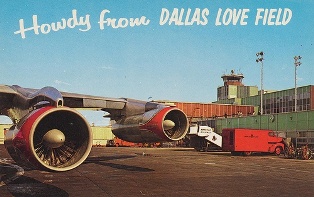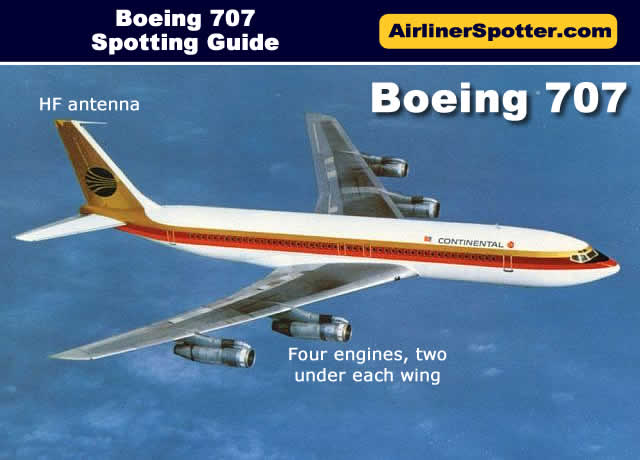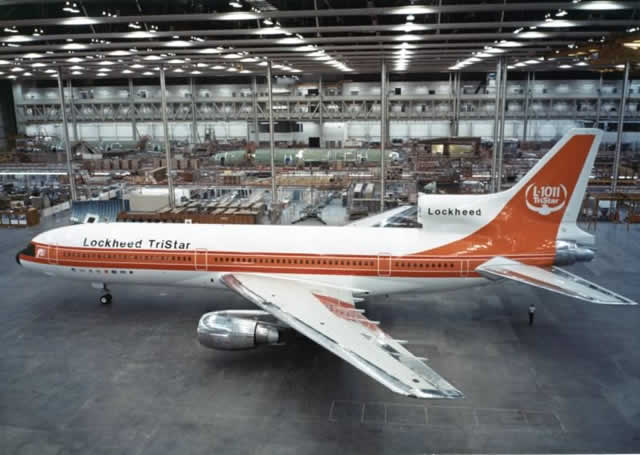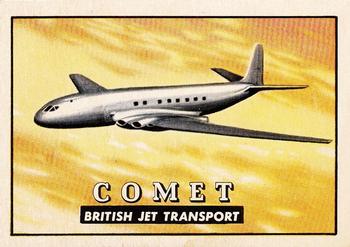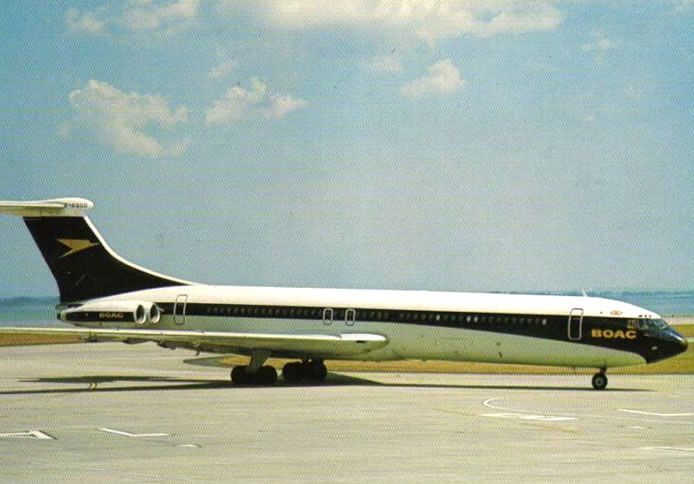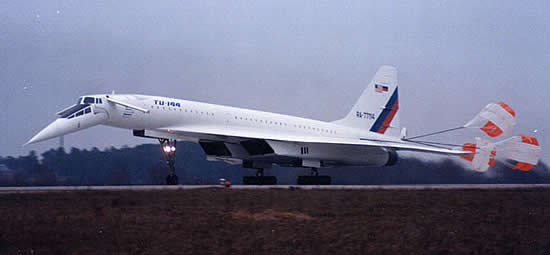Jet Airliners of the Past
|
The jet age of passenger travel began in the late 1950s with the arrival of the Boeing 707, the Convair 880 and the Douglas DC-8.
Later aircraft included the Convair 990, Douglas DC-9 and McDonnell-Douglas DC-10 and MD-11, and Lockheed L-1011 Tristar.
We weren't able to photograph airliners in those earlier times. But we have included on this page representative images of these earlier jet airliners of the past from our collection of vintage postcards, and some of our original photographs from airplane boneyards.
Images of Bygone Airlines
The images on this page offer a great opportunity to look back on some of the airlines that existed before the mega-mergers of the airline industry today, such as these:
- Pan American World Airways
- British Caledonian
- Northeast Airlines
- Northwest Orient Airlines
- National Airlines
- British Overseas Airways Corporation (BOAC)
- Trans World Airlines
- Western Airlines
- Republic Airlines
Where to Spot Out-of-Date Airliners: Airplane Boneyards
 Airliners in storage at the Phoenix Goodyear Airport in the Arizona desert, including an Iberia A340
(Staff photo) Airliners in storage at the Phoenix Goodyear Airport in the Arizona desert, including an Iberia A340
(Staff photo) |
Commercial airliners all have limited lifespans. Ultimately, they must be retired from service, stored in "airplane boneyards" or graveyards, and finally dismantled and scrapped.
Jetliners eventually reach end-of-life due to airframe wear, obsolescence, or fuel inefficiency. Some jetliners are temporarily taken off flying status, and must be stored in a environment that is conducive to preservation. Others are kept for spare parts for flying aircraft.
To protect airliners from rust and corrosion during their storage, they are typically stored in dry, desert conditions. Engines and windows are covered with white, reflective materials to protect from wind and sun damage. A sealed airliner can be stored safely for years, until the time comes to return it to active duty, or salvage. Eventually, all airliners are removed permanently from service and must be "disposed" of.
Airplane boneyards are a good place to spot airliners that you can't see anywhere else.
In the past year, we have spotted Boeing 707, DC-8, DC-10, MD-11 and a variety of Airbus aircraft in various boneyards in the western U.S., including:
- Mojave Airport in California
- Southern California Logistics Airport (SCLA) in Victorville, California
- Pinal Airpark near Tucson, Arizona
- Phoenix Goodyear Airport in Arizona
- Kingman Airport, Kingman Arizona
Also available is information on airliner boneyards in Europe, the UK, Australia, Russia and other locations around the world.
... and view photos of commercial airliner boneyards at www.AirplaneBoneyards.com
Boeing 707
The commercial 707 and the military C-135 shared many similarities and components. However, the airlines wanted the 707 fuselage to be 4 inches wider than the tanker version. Its width and the 100-foot length made it the largest passenger cabin in the air. Placement of more than 100 windows allowed airlines to rearrange seats. Location of passenger doors on the left side, at the front and at the rear of the cabin, became standard for subsequent Boeing jets.
Its cruising speed of 575 miles an hour was 225 miles an hour faster than its nearest propeller-powered rival.
The 4-engine 707 entered commercial service on October 26, 1958, when Pan Am flew 111 passengers on its 707-121 "Clipper America" (N711PA) from New York's Idlewild Airport to Paris in 8 hours and 41 minutes, twice as fast as a piston-engine airliner. The flight stopped at Gander, Newfoundland to refuel.
Boeing 720 and Other Variants
Boeing custom-designed 707 variants for different customers. It built special long-range models for Qantas Airways of Australia, and installed larger engines for Braniff's high-altitude South American routes.
A number of variants were developed for special use, including shorter-bodied airplanes and the 720 series, which was lighter and faster with better runway performance. The 707 was designated the 720 when it was modified for short-to-medium routes and for use on shorter runways. On the 720 engineers reduced the fuselage length by 9 feet, changed the leading-edge flaps and later installed turbofan engines.
Shown below is an image of a four-engine Boeing 707 of Continental Airlines |
| Boeing 707-121 jetliners prior to delivery to Pan American in 1958 |
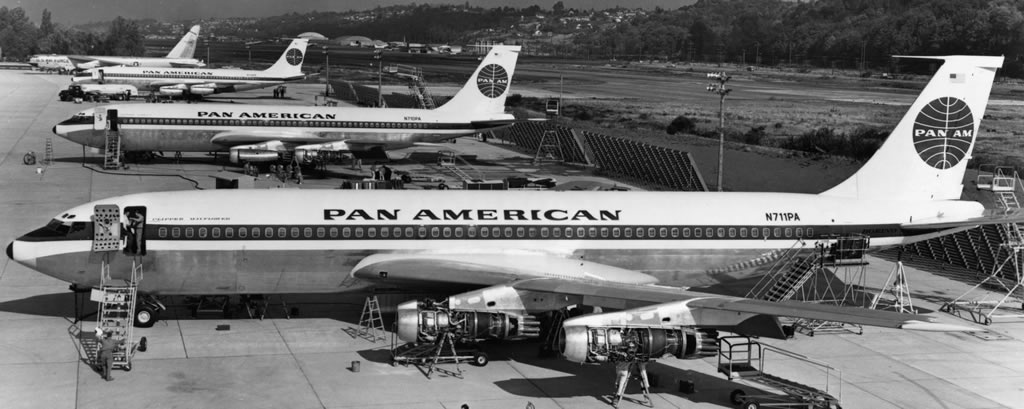 |
Boeing 707 - Lufthansa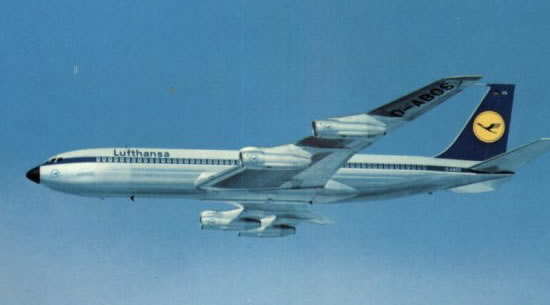 |
Boeing 707 - British Airtours |
Boeing 707 - British Caledonian |
Boeing 707 - BOAC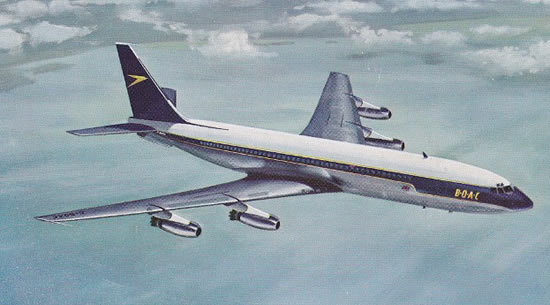 |
More about the Boeing 707 history, production, photographs and spotting tips
Douglas DC-8
 Douglas DC-8 Super 60 takeoff at Tampa International Airport |
The DC-8 was the first Douglas jetliner, entering service with United Airlines and Delta Air Lines in September of 1959. Powered by four jet turbine engines, the DC-8 was capable of speeds of more than 600 mph.
The DC-8 Series 10 domestic version had increased fuel capacity for intercontinental flights, and the Series 30 and 40 were the first to use the 17,500-pound-thrust turbojet engines.
The Series 50 was the first version to be offered in the convertible passenger-freight version or a windowless all-freight version.
The extended DC-8-61 could carry 259 people. The DC-8-62, for extra-long routes, had a fuselage stretched 6 feet 8 inches longer than the original model.
Throughout its 14-year-long production run, the DC-8 went through a total of seven major variants, with 556 aircraft built.
DC-8 Delta Air Lines |
DC-8 Delta Air Lines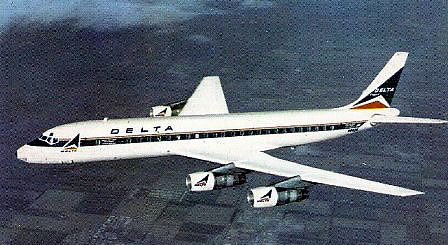 |
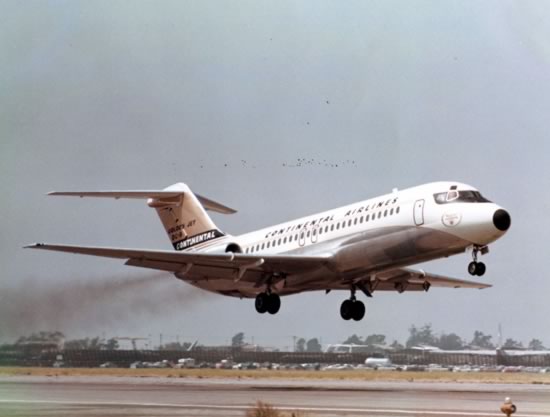 DC-9 of Continental Airlines DC-9 of Continental Airlines |
Douglas DC-9
The DC-9 was designed by the Douglas Aircraft Company for frequent, short flights. It was first assembled in 1965 with its maiden flight later that year.
Its T-tail design featured 2-engines mounted on the rear fuselage.
Models included the original DC-9-10 and stretched models up to the DC-9-50.
The DC-9 evolved into the MD-80 and MD-90 Series of airliners built by McDonnell-Douglas, and later into the Boeing 717.
A total of 976 aircraft were built by the time production ended in October of 1982.
DC-9 Hughes Airwest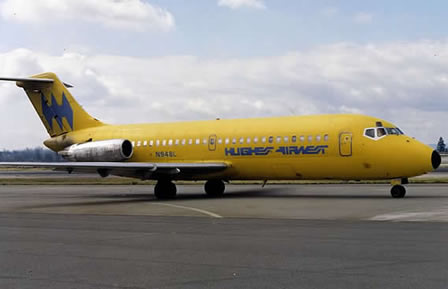 |
DC-9 Republic Airlines |
DC-9 TranStar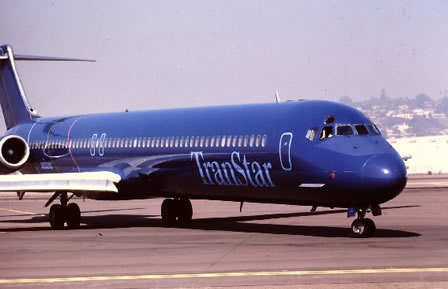 |
DC-9 Northeast Airlines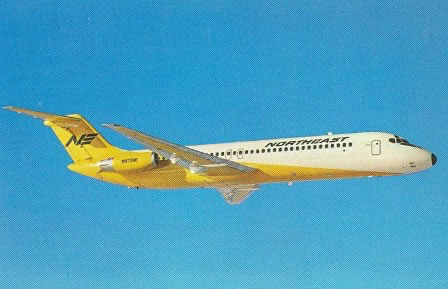 |
McDonnell-Douglas DC-10
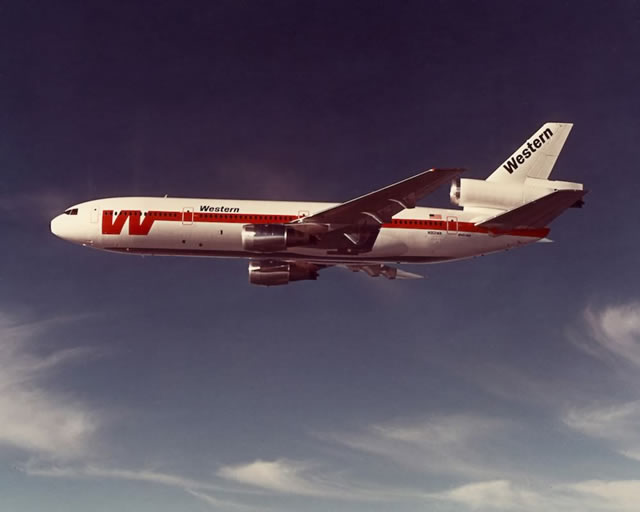 Western Air Lines Douglas DC-10 tri-jet airliner Western Air Lines Douglas DC-10 tri-jet airliner |
The McDonnell-Douglas DC-10 was a medium to long-range, wide-body, trijet. Its design featured an engine mounted on pylons under each wing, and a third engine mounted in the base of the vertical stabilizer.
Designed as a successor to the McDonell-Douglas DC-8, it could carry 380 passengers up to 6,600 miles. It was marketed to those airlines seeking a jetliner smaller than the Boeing 747 but with transcontinental range and wide-body comfort for passengers.
The DC-10 series included the DC-10-10 and DC-10-15, and longer range DC-10-30 and DC-10-40 variants. Assembly was done at the McDonnell-Douglas plant in Long Beach, California.
McDonnell-Douglas delivered a total of 386 DC-10 airliners between 1968 and 1988.
DC-10 Northwest Orient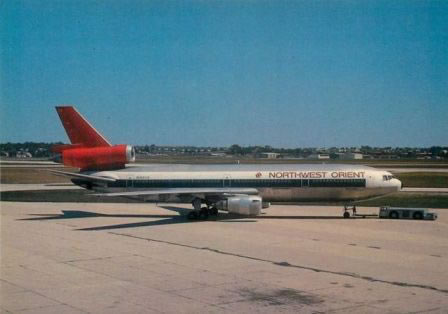 |
DC-10 National Airlines |
| Brazilian cargo VarigLog DC-10 airliners in storage at the Pinal Airpark in Arizona (Staff Photo) View similar photos at AirplaneBoneyards.com |
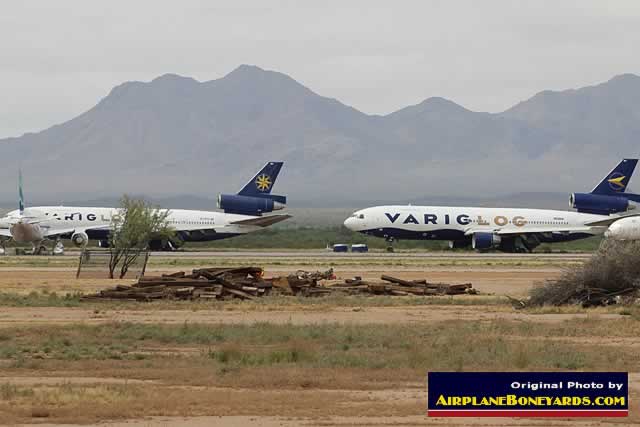 |
McDonnell-Douglas MD-11
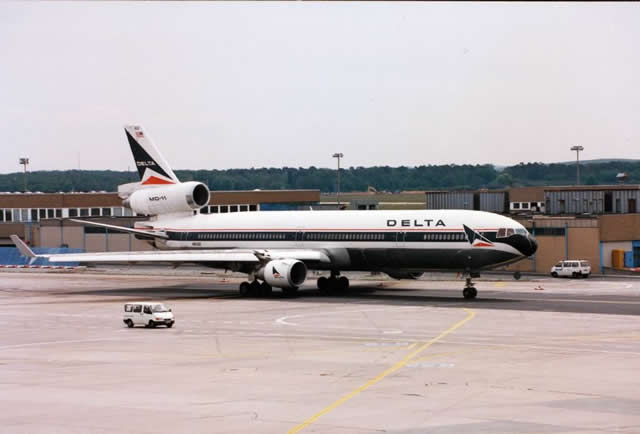 Delta Air Lines McDonnell-Douglas MD-11 wide-body, tri-jet airliner Delta Air Lines McDonnell-Douglas MD-11 wide-body, tri-jet airliner |
To continue development of its tri-jet airliner series, McDonnell-Douglas designed the MD-11, which features a stretched fuselage, longer wingspan with winglets, a smaller tailplane, new engines and a glass cockpit.
McDonnell-Douglas delivered a total of 200 MD-11 airliners between 1988 and 2000.
Most models, 131 aircraft, were the basic passenger variant, while 53 of the freighter variant MD-11F were built. Other variants included the MD-11ER, MD-11CF and MD-11C.
In 2016, about 120 MD-11s remained in service with cargo operators, mostly with FedEx Express, United Parcel Service, and Lufthansa Cargo.
| FedEx MD-11F parked at the Southern California Logistics Airport in Victorville, California (Staff Photo) View similar photos at AirplaneBoneyards.com |
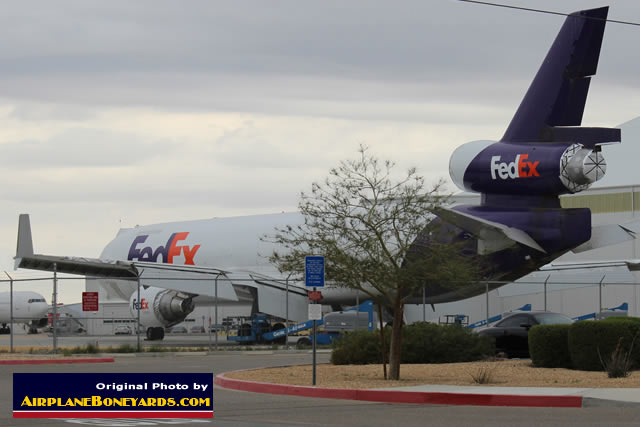 |
Lockheed L-1011 Tristar
The Lockheed L-1011 TriStar was a medium to long-range, wide-body, trijet launched in March of 1968. The original orders were from Eastern Air Lines for 50 Tristars, Trans World Airlines for 44, and British Air Holdings, Ltd for 50.
|
Assembly of the first Tristar began in March of 1969, and the of official roll-out was held in September. All Tristars would be built at the Lockheed plant at the Palmdale Regional Airport in southern California near Los Angeles.
It could seat up to 400 passengers, and had a range of over 4,000nm. The aircraft featured vastly improved avionics not found in previous jetliners.
Eastern Air Lines took delivery of its first "Whisperliner" (N306EA) on April 6, 1972.
The L-1011 was produced in two fuselage lengths, including the original L-1011-1. The shortened, longer range L-1011-500 variant first flew in 1978, and entered service with British Airways a year later.
The production and sales of the L-1011 suffered from the design limitation of only using Rolls Royce engines, which had serious development problems that eventually forced Rolls Royce into bankruptcy.
Between 1968 and 1984 when production ended, Lockheed produced a total of 250 TriStars.
Convair 880
The Convair 880 was a narrow-body, four-engine jetliner built by the Convair division of General Dynamics, designed to compete with the Boeing 707 and Douglas DC-8 by being smaller and faster. Production ran from 1959 to 1962, with 65 880s built.
Primary operators include Delta Air Lines, Trans World Airlines, Japan Airlines, Swissair, Northeast AIrlines and Alaska Air Lines.
| Alaska Air Lines Convair 880 |
 |
Convair 990 Coronado
The Convair 990 was a stretched version of the 880 designed at the request of American Airlines. Only 37 of the jetliners were assembled. Primary operators included American and Swissair.
A noticeable design change from the 880 was the large anti-shock bodies on the upper trailing edge of the wings to increase the critical Mach and reduce transonic drag.
| The beautiful, sleek four-engine Convair 990 of Swiss Air |
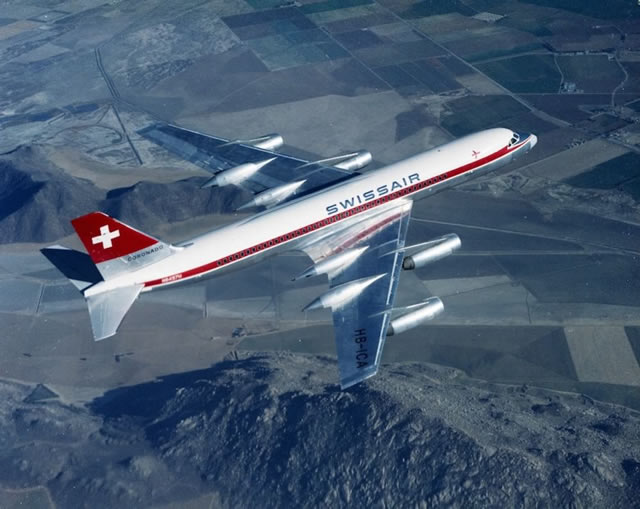 |
American Airlines Convair 990 Astrojet |
| Convair 990 Jetliner gatekeeper on display at the entrance to the Mojave Airport in California. It was NASA's N810NA Space Shuttle landing gear system test aircraft (Staff Photo) |
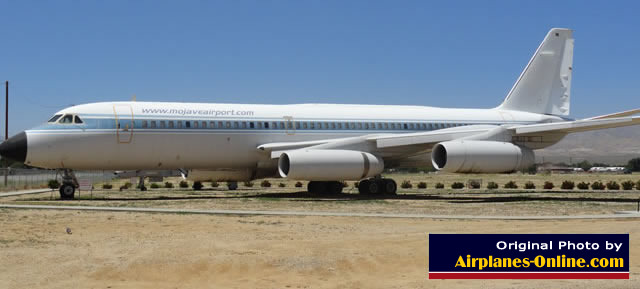 |
Boeing 727
The 727 followed the Boeing 707, a quad-jet airliner, with which it shared its upper fuselage cross-section and cockpit design. The 727-100 first flew in February of 1963 and entered service with Eastern Air Lines in February of 1964.
The stretched 727-200 flew in July of 1967 and entered service with Northeast Airlines that December. The 727 became a mainstay of airlines' domestic route networks and was also used on short- and medium-range international routes.
Passenger, freighter, and convertible versions of the 727 were built. A total of 1,831 727 airliners were produced by Boeing.
De Havilland Comet
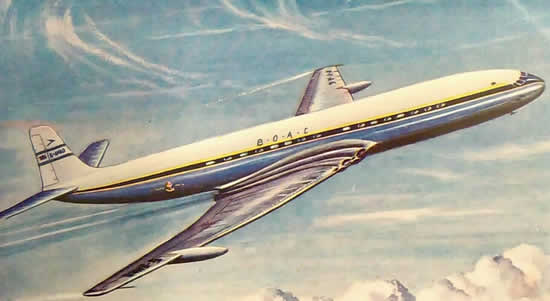 BOAC de Havilland Comet Mark 4 |
The de Havilland DH 106 Comet was the world's first commercial jet airliner. It was developed and manufactured by de Havilland at its Hatfield Aerodrome in Hertfordshire, United Kingdom. The Comet 1 prototype first flew in 1949.
The early Comet was withdrawn from service and extensively tested after three crashes. Design and construction flaws, including improper riveting and stress around some of its square windows, were identified. The Comet was subsequently redesigned, with oval windows, structural reinforcements and other changes.
The most successful variant of the type was the Comet 4.
The Mark 4 had four Avon jet engiens with a total thrust of 42,000lbs. It had a range of 2,600 miles at 500mph, flying at 40,000 feet. It was 11 feet in length and had a windspan of 115 feet, and could carry from 58 to 78 passengers.
A total of 114 Comets were built, including prototypes.
Concorde SST
The Aérospatiale/BAC Concorde was a British–French turbojet-powered supersonic passenger airliner.
It had a maximum speed over twice the speed of sound, at Mach 2.04 (1,354 mph), with seating for 92 to 128 passengers.
First flown in 1969, Concorde entered service in 1976 and continued flying until 2003.
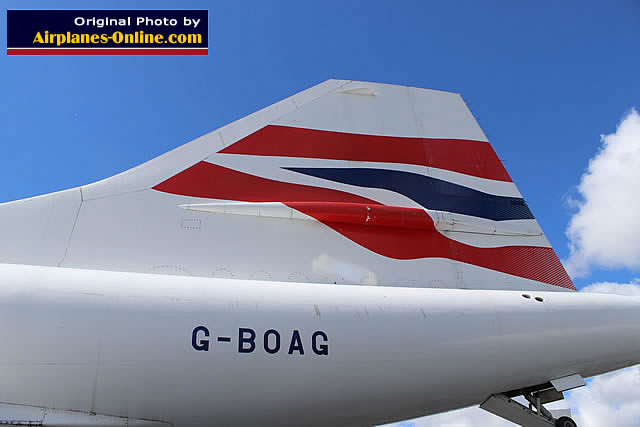 British Airways Concorde G-BOAG (Staff Photo) |
It was operated by British Airways and Air France.
When production ended, a total of only 20 Concordes had been built. But 18 survive, on display at museums in the United Kingdom, France, the United States, Germany, and Barbados.
Shown to the right is a photo of G-BOAG on display at the Museum of Flight in Seattle, Washington.
Sud Aviation Caravelle
The Sud Aviation SE 210 Caravelle was the world's first short-to-medium-range jet airliner, produced by the French Sud Aviation company.
It was also the first jet airliner to be designed with the engines mounted on the rear of the fuselage. This design made for a quieter cabin.
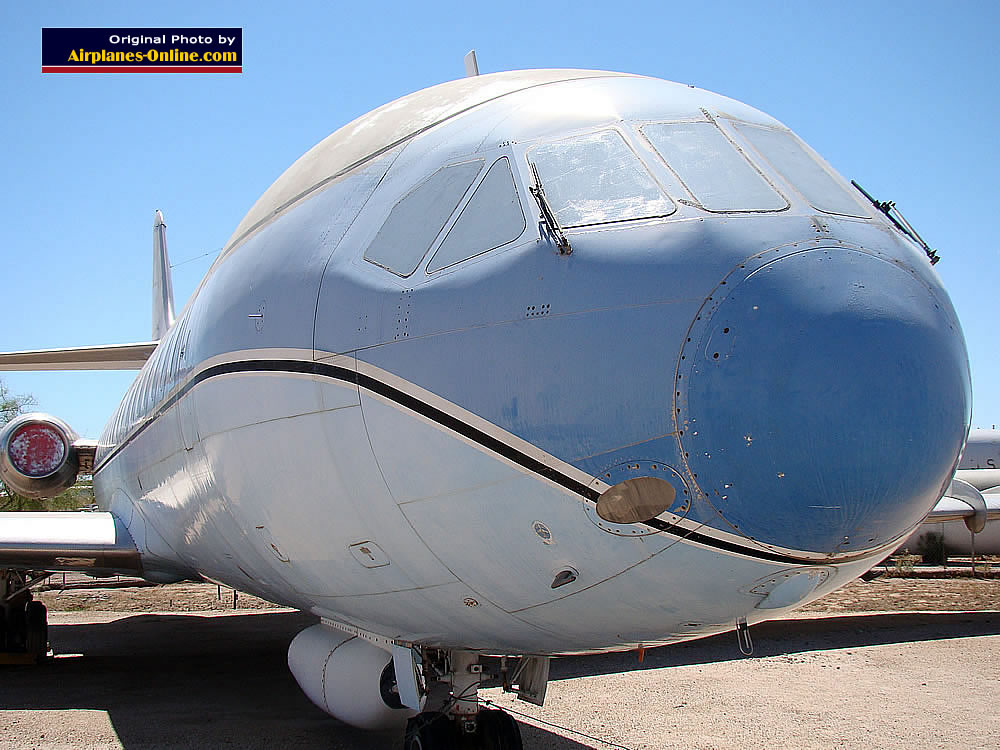 Sud Aviation SE 210 Caravelle on display at the Pima Air and Space Museum in Tucson, Arizona (Staff Photo) |
The Caravelle was the first jet airliner manufactured in Europe outside of England. The aircraft was designed in response to a French government requirement for a medium-range airliner for Air France.
Its maiden flight occurred in 1955, and the aircraft entered service in 1959; a total of 282 Caravelles were built.
BAC-111
The British Aircraft Corporation One-Eleven, known as the BAC-111 was popular in the early days of jet travel; it had a similar appearance and twin-engine configuration to the DC-9.
The aircraft proved popular with domestic airlines and various international operators. Over half of the BAC-111 sales at launch were to U.S. carriers. The One-Eleven was one of the most successful British airliner designs, and served until a widespread retirement in the 1990s, which was partly due to the introduction of aircraft noise restrictions in many European nations.
But the BAC-111 is long out-of-service; you won't spot one unless it is featured in an aviation museum.
| British Caledonian BAC-111 |
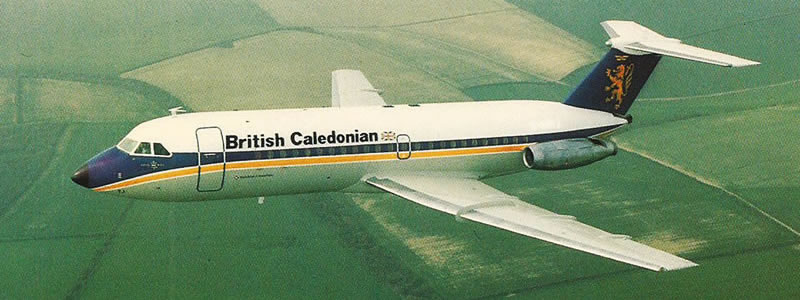 |
Vickers VC10
|
The Vickers VC10 was a mid-sized, narrow-body long-range British jet airliner designed and built by Vickers-Armstrongs (Aircraft) Ltd. The VC10 was closely constrained by its BOAC specification which required operation from short airfields in Africa at high altitudes and temperatures (hot and high). This suited a number of African and Middle Eastern operators but restricted its appeal with other operators around the world.
The performance of the VC10 enabled it to achieve the sub-sonic record for a Trans-Atlantic crossing of just 5 hours 1 minute.
Its design featured four rear-mounted Rolls-Royce Conway jet engines, and a large T-tail.
Operators included BOAC, British United Airways (subsequently British Caledonian), East African Airways, Ghana Airways, Air Malawi and the Royal Air Force.
Although only 54 of the airliners were assembled, it provided air service from the 1960s to 1981.
| A 4-engine Vickers VC10 of Gulf Air |
 |
Hawker Siddeley Trident of Northeast Airlines |
Hawker Siddeley Trident
The Hawker Siddeley HS 121 Trident (originally the de Havilland D.H.121 and the Airco DH 121) was a British short-medium range airliner.
It was the first T-tail rear-engined three-engined jet airliner to be designed.
It was built during 1962-1978; a total of 117 Tridents were assembled and put into service. It could carry between 101-180 passengers.
Tupolev Jetliners
Tupolev is a large, Russian-based company involved in the development, manufacturing, and overhaul of both civil and military aerospace products such as aircraft and weapons systems.
|
It is also engaged in the fields of missile and naval aviation technologies.
It developed the U.S.S.R.’s first commercial jetliner and the world’s first supersonic passenger jet.
A number of commercial aircraft have been included in the Tupolev product line, such as the Tu-134, Tu-154, Tu-204, Tu-214 and many others.
During the 1960s Tupolev undertook the design and construction of a delta-wing supersonic transport, the Tu-144, similar in overall design to the British and French Concorde. In June of 1969 the Tu-144 became the first passenger jet to fly faster than the speed of sound.
Tupolev Tu-154 Medium-Range, Narrow-body Airliner
|
The design of the Tu-154 features a T-Tail, three-engine configuration in the tail, and two six-wheel main landing gear arrangements. It also utilizes on each side of the fuselage three cabin doors along with two over-the-wing emergency exit doors.
Capable of operating from unpaved and gravel airfields with only basic facilities, the Tu-154 was widely used in the extreme Arctic conditions of Russia's northern/eastern regions where other airliners were unable to operate.
Seating capacity ranges from 164 - 180 passengers. In total, 930 Tu-154 aircraft were built.
 Tupolev Tu-134 Airliner |
Tupolev Tu-134 Jetliner
The Tu-134 was a narrow-body, twin-engine airliner produced by Tupolev from 1966 to 1989. When production ended, a total of 854 Tu-143 aircraft had been built.
The Tu-134 experienced long-term service within 42 countries, with some European airlines scheduling as many as 12 daily takeoffs and landings per plane.
Typical passenger configurations included 72 - 84 seats. In addition to regular passenger service, it has been used in various air force, army and navy support roles.


